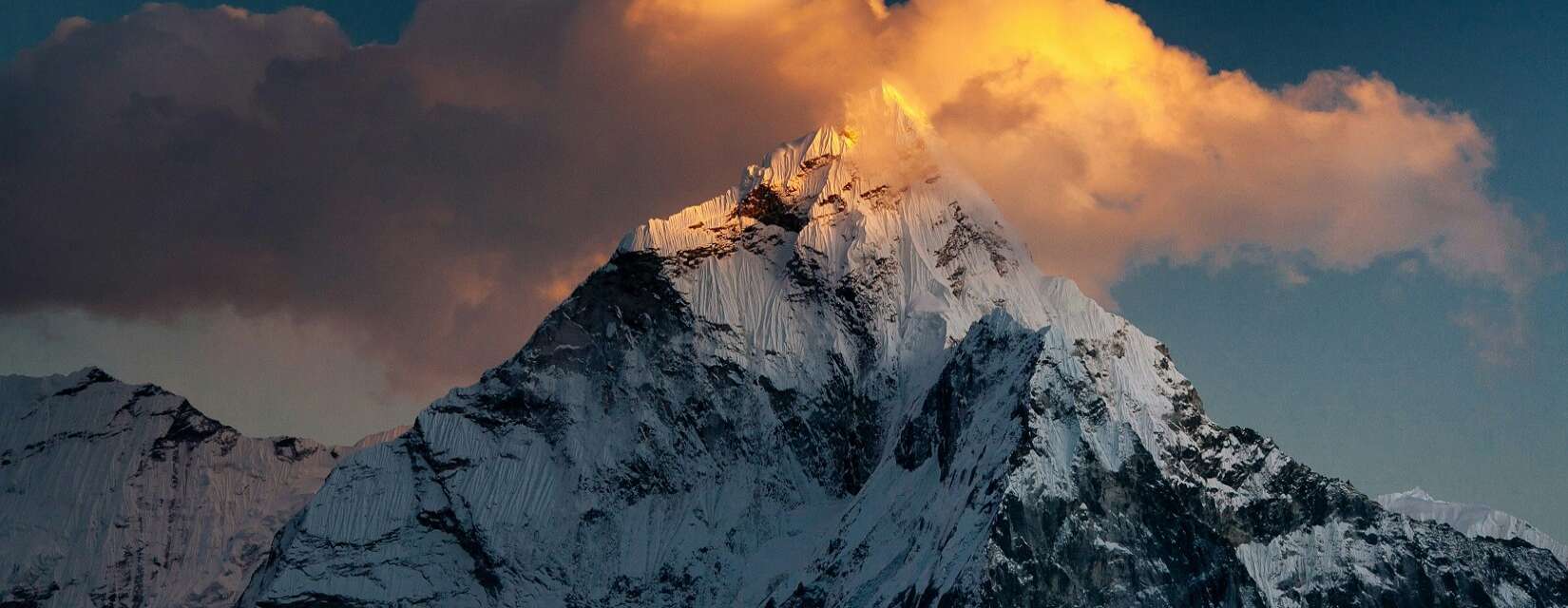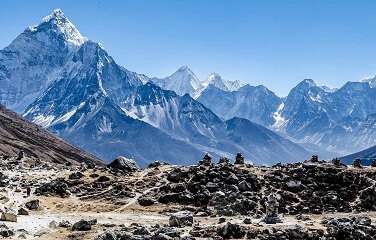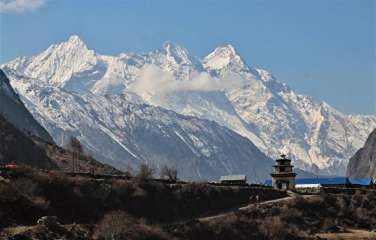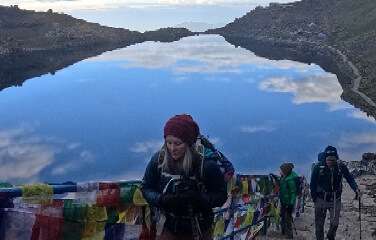Stunning Scenery:

The stunning scenery of Himalayan Nepal is awe-inspiring and varied, encompassing majestic peaks, verdant valleys, tranquil lakes, and vibrant forests. Here's a glimpse into some of the most breathtaking landscapes in the region:
Snow-Capped Peaks:
Mount Everest (Sagarmatha): The highest peak in the world, Everest's snow-clad summit dominates the skyline of the Everest region. Trekkers often catch glimpses of Everest from viewpoints along trails like the Everest Base Camp Trek.
Annapurna Range: The Annapurna massif boasts several peaks over 7,000 meters, including Annapurna I, the 10th highest peak in the world. The dramatic peaks of the Annapurna Range create a stunning backdrop for treks like the Annapurna Circuit and Annapurna Base Camp.
Langtang Range: Nestled north of Kathmandu, the Langtang Range features snow-capped peaks, including Langtang Lirung and Dorje Lakpa. Trekkers in the Langtang Valley are treated to panoramic views of these majestic mountains.
Pristine Lakes:

Gokyo Lakes: Situated in the Everest region, the Gokyo Lakes are a series of glacial lakes renowned for their turquoise waters. Trekkers on the Gokyo Lakes Trek are treated to stunning views of these shimmering lakes against the backdrop of snow-capped peaks.
Phewa Lake: Located in Pokhara, Phewa Lake is the second-largest lake in Nepal and offers mesmerizing reflections of the Annapurna Range on clear days. Boating on Phewa Lake is a popular activity for visitors to Pokhara.
Tilicho Lake: Situated at an altitude of over 4,900 meters in the Annapurna region, Tilicho Lake is one of the highest lakes in the world. Trekkers on the Annapurna Circuit can take a detour to visit this stunning glacial lake.
Verdant Valleys and Forests:
- Khumbu Valley: Home to the Everest region, the Khumbu Valley is characterized by lush valleys dotted with Sherpa villages, terraced fields, and rhododendron forests. The vibrant colors of the flora contrast beautifully with the surrounding mountains.
- Langtang Valley: Known as the "Valley of Glaciers," Langtang Valley is adorned with lush forests of rhododendrons, oak, and pine trees. Waterfalls cascade down rocky cliffs, creating a picturesque setting for trekkers.
- Annapurna Sanctuary: Encircled by towering peaks, the Annapurna Sanctuary is a natural amphitheater carpeted with alpine meadows and bamboo forests. Trekkers on the Annapurna Base Camp Trek are immersed in this serene and mystical landscape.
Remote High-Altitude Plateaus:
- Upper Mustang: The high-altitude desert of Upper Mustang features barren landscapes, eroded cliffs, and ancient cave dwellings. The surreal terrain of Upper Mustang offers a unique and otherworldly trekking experience.
- Manang Valley: Nestled in the Annapurna region, the Manang Valley is characterized by its arid landscapes, Tibetan Buddhist culture, and traditional stone-built villages. Trekkers traverse high-altitude plateaus and rugged terrain while enjoying panoramic mountain views.
The stunning scenery of Himalayan Nepal is not only a visual feast but also a source of inspiration, adventure, and spiritual rejuvenation for trekkers and nature lovers from around the world. Whether exploring high-altitude peaks, tranquil lakes, or verdant valleys, Nepal's Himalayas never fail to leave a lasting impression.
Cultural Immersion:

Cultural immersion in Himalayan Nepal is an enriching experience that allows travelers to connect with diverse ethnic groups, ancient traditions, and vibrant customs. Here are some facets of cultural immersion in Himalayan Nepal:
Ethnic Diversity:
- Sherpa Culture: The Sherpas, renowned for their mountaineering prowess, inhabit the Everest region. Trekkers can visit Sherpa villages like Namche Bazaar, Khumjung, and Tengboche to experience their unique lifestyle, hospitality, and Buddhist traditions.
- Gurung Culture: The Gurungs are one of the major ethnic groups in the Annapurna region. Trekkers on the Annapurna Circuit and Annapurna Base Camp treks have the opportunity to interact with Gurung communities, known for their rich culture, traditional music, and hospitality.
- Tamang Culture: The Tamangs are prevalent in the Langtang region, particularly around the Langtang Valley. Trekkers can stay in Tamang villages, participate in cultural ceremonies, and learn about their distinct language, dance, and craftsmanship.
- Thakali Culture: The Thakalis are known for their entrepreneurial spirit and cuisine, particularly in the Mustang and Manang regions. Trekkers can sample traditional Thakali dishes like dal bhat and thukpa while learning about their trading heritage and religious practices.
Religious Traditions:
- Buddhism: Tibetan Buddhism permeates the Himalayan regions of Nepal, with monasteries, stupas, and prayer flags dotting the landscape. Trekkers can visit sacred sites like Tengboche Monastery, Swayambhunath Stupa (Monkey Temple), and Muktinath Temple to witness Buddhist rituals and teachings.
- Hinduism: Hinduism is the predominant religion in the lowland areas of Nepal, including Kathmandu and Pokhara. Trekkers can explore Hindu temples and shrines like Pashupatinath Temple, Boudhanath Stupa, and Bindhyabasini Temple, and participate in religious festivals like Dashain and Tihar.
Traditional Festivals:
- Mani Rimdu: Celebrated by the Sherpas in the Everest region, Mani Rimdu is a colorful Buddhist festival featuring masked dances, religious ceremonies, and symbolic rituals. Trekkers can witness this vibrant festival at Tengboche Monastery during certain times of the year.
- Tihar: Also known as the Festival of Lights, Tihar is a major Hindu festival celebrated throughout Nepal. Trekkers can experience the festive atmosphere, colorful decorations, and cultural performances in villages along trekking routes during Tihar.
Handicrafts and Cuisine:
-
Handicrafts: Nepalese artisans produce a wide range of traditional handicrafts, including handwoven textiles, pottery, metalwork, and woodcarvings. Trekkers can purchase these artisanal products as souvenirs and support local communities.
- Cuisine: Nepalese cuisine varies by region and ethnic group but typically includes staples like dal bhat (lentil soup with rice), momos (dumplings), and thukpa (noodle soup). Trekkers can savor authentic Nepalese dishes in teahouses and local eateries along trekking routes.
Homestays and Cultural Exchanges:
- Homestays: Many trekking routes offer opportunities for homestays with local families, providing an immersive cultural experience. Staying with host families allows trekkers to learn about daily life, participate in household activities, and forge meaningful connections.
- Cultural Exchanges: Trekking guides and porters often share their knowledge of local culture, history, and traditions with trekkers, fostering cultural exchanges and mutual understanding.
Cultural immersion in Himalayan Nepal is not just about sightseeing; it's about engaging with local communities, respecting traditions, and embracing the rich tapestry of cultures that define the region's identity. Whether attending a religious festival, sampling traditional cuisine, or staying in a remote village, travelers can gain a deeper appreciation for the cultural heritage of Himalayan Nepal.
Adventure and Challenge:

Adventure and challenge are inherent aspects of trekking and exploring the Himalayan region of Nepal. Here's a look at some of the thrilling experiences and formidable challenges that trekkers encounter:
Adventure:
- High-Altitude Trekking: Trekking in the Himalayas often involves ascending to high altitudes, where trekkers can experience breathtaking scenery, pristine wilderness, and a sense of adventure unlike anywhere else on earth.
- Iconic Trails: Nepal boasts some of the world's most iconic trekking routes, including the Everest Base Camp Trek, Annapurna Circuit, and Langtang Valley Trek. These trails offer diverse landscapes, cultural encounters, and unforgettable experiences.
- Peak Climbing: For those seeking a greater challenge, Nepal offers numerous opportunities for peak climbing, including Island Peak, Mera Peak, and Lobuche Peak. Climbing these peaks requires technical skills, physical fitness, and an appetite for adventure.
- Remote Exploration: Trekking in remote and off-the-beaten-path areas allows trekkers to immerse themselves in untouched wilderness, discover hidden gems, and forge a deeper connection with nature and culture.
- Cultural Encounters: Adventure in Nepal isn't just about the landscapes; it's also about engaging with diverse ethnic groups, learning about ancient traditions, and experiencing the warmth and hospitality of local communities.
Challenges:
- High Altitude: Trekking in the Himalayas often involves ascending to high altitudes, where trekkers may experience altitude-related symptoms such as headache, fatigue, and nausea. Acclimatization and proper altitude management are essential to minimize the risk of altitude sickness.
- Variable Weather: Weather conditions in the Himalayas can be unpredictable, with rapid changes in temperature, wind, and precipitation. Trekkers must be prepared for all types of weather and dress in layers to stay comfortable.
- Rugged Terrain: Trekking trails in Nepal can be rugged and challenging, featuring steep ascents, rocky terrain, and narrow paths along cliffsides. Trekking poles and sturdy footwear are essential for navigating uneven terrain.
- Remote Locations: Many trekking routes in Nepal pass through remote and isolated areas with limited access to medical facilities, communication networks, and emergency services. Trekkers must be self-sufficient and prepared to handle emergencies.
- Physical Demands: Trekking in the Himalayas requires a good level of physical fitness, endurance, and mental resilience. Long hours of walking, carrying a backpack, and navigating challenging terrain can be physically demanding, especially at high altitudes.
Overcoming Challenges:

- Proper Preparation: Adequate physical training, mental preparation, and research are essential for a successful trekking experience in Himalayan Nepal. Training should include cardiovascular exercises, strength training, and hiking with a loaded backpack.
- Acclimatization: Gradual ascent and acclimatization are crucial for preventing altitude sickness. Trekkers should follow recommended acclimatization schedules, stay hydrated, and listen to their bodies for any signs of altitude-related symptoms.
- Safety Measures: Trekkers should prioritize safety at all times, including staying on marked trails, following the advice of experienced guides, and carrying essential safety equipment such as a first aid kit, emergency shelter, and communication devices.
- Resilience and Adaptability: Himalayan trekking often presents unexpected challenges and obstacles. Trekkers must remain flexible, patient, and resilient in the face of adversity, adapting their plans as needed to ensure a safe and enjoyable experience.
Despite the challenges, the adventure of trekking in Himalayan Nepal is a rewarding and transformative experience, offering trekkers the opportunity to push their limits, explore remote landscapes, and create lifelong memories. With proper preparation, a spirit of adventure, and respect for the environment and local cultures, trekkers can embark on an unforgettable journey in the heart of the world's highest mountains.
Supporting Local Economy:
Supporting the local economy in Himalayan Nepal is vital for sustainable tourism development and community empowerment. Here are some ways travelers can contribute positively to the local economy during their trekking adventures:
Engage Local Guides and Porters:
- Hire Local Guides: Hiring local guides not only enhances the trekking experience but also provides employment opportunities for trained professionals from the region. Local guides offer valuable insights into the culture, history, and geography of the area.
- Employ Local Porters: Utilizing the services of local porters not only lightens the load for trekkers but also provides much-needed income for porters and their families. Portering is a traditional livelihood in many Himalayan communities, and employing local porters helps sustain this important profession.
Stay in Local Accommodations:
- Teahouse Lodges: Opt for accommodations in teahouse lodges run by local families along trekking routes. Staying in teahouses not only supports local businesses but also allows travelers to experience authentic Nepalese hospitality and cuisine.
- Homestays: Consider staying in homestays with local families for a more immersive cultural experience. Homestays provide an opportunity to learn about traditional ways of life, participate in household activities, and foster cross-cultural exchanges.
Shop Locally:
- Purchase Local Products: Support local artisans and entrepreneurs by purchasing handmade crafts, textiles, and souvenirs produced in the region. Look for authentic Nepalese products such as handwoven fabrics, pottery, jewelry, and traditional artwork.
- Buy from Local Markets: Visit local markets and shops along trekking routes to buy provisions, snacks, and supplies. Purchasing goods from local vendors helps inject money into the local economy and supports small businesses.
Contribute to Community Projects:
-
Donate to Local Initiatives: Support community-led projects and initiatives aimed at improving education, healthcare, infrastructure, and environmental conservation in Himalayan villages. Many trekking agencies and NGOs facilitate donations and volunteer opportunities for travelers.
- Participate in Responsible Tourism Programs: Join responsible tourism programs that give back to local communities, such as village development projects, cultural preservation efforts, and sustainable tourism initiatives. These programs promote community empowerment and equitable distribution of tourism benefits.
Respect Local Customs and Traditions:
- Cultural Sensitivity: Respect local customs, traditions, and religious beliefs during your trekking journey. Learn about local etiquette, dress codes, and social norms to ensure that your interactions with community members are respectful and positive.
- Environmental Stewardship: Practice responsible environmental stewardship by minimizing waste, conserving water and energy, and following Leave No Trace principles. Respect wildlife habitats, refrain from littering, and minimize your ecological footprint to preserve the natural beauty of the Himalayan region for future generations.
By supporting the local economy in Himalayan Nepal, travelers can contribute to sustainable development, foster cultural exchange, and create positive impacts that benefit both local communities and the environment.
Top Treks in Nepal

Trekking in Himalayan Nepal offers a wide range of options, catering to different preferences, fitness levels, and time constraints. Here are some details about popular treks in the region:
- Everest Base Camp Trek: One of the most famous treks in the world, the Everest Base Camp Trek takes you through the heart of the Khumbu region, offering stunning views of Everest and surrounding peaks. The journey typically starts with a flight to Lukla, followed by a trek through Sherpa villages, monasteries, and high-altitude landscapes before reaching the Everest Base Camp.
- Annapurna Circuit Trek: Renowned for its diverse landscapes and cultural experiences, the Annapurna Circuit Trek circles the Annapurna Massif, passing through lush valleys, rhododendron forests, and traditional Gurung and Magar villages. Highlights include crossing the Thorong La Pass and visiting the sacred temple of Muktinath.
- Langtang Valley Trek: Close to Kathmandu yet offering pristine alpine scenery, the Langtang Valley Trek is ideal for those with limited time. The trek takes you through lush forests, charming villages, and high-altitude pastures, with views of snow-capped peaks and encounters with local wildlife.
- Manaslu Circuit Trek: Less crowded than the Everest and Annapurna regions, the Manaslu Circuit Trek provides a remote and culturally rich experience. The trail circumnavigates the eighth highest peak in the world, Mt. Manaslu, passing through diverse landscapes and traditional Tibetan villages.
- Upper Mustang Trek: Known as the "Last Forbidden Kingdom," Upper Mustang offers a unique trekking experience in a culturally preserved region. The trek takes you to the arid landscapes of the Mustang region, with its ancient monasteries, caves, and Tibetan-influenced culture.
- Gokyo Lakes Trek: A scenic alternative to the Everest Base Camp Trek, the Gokyo Lakes Trek leads trekkers to the turquoise glacial lakes of Gokyo, offering panoramic views of Everest, Lhotse, and Cho Oyu. The trek also includes a hike to Gokyo Ri for a stunning sunrise view.
- Kanchenjunga Base Camp Trek: For those seeking remote and off-the-beaten-path adventures, the Kanchenjunga Base Camp Trek explores the eastern Himalayas, passing through lush forests, terraced fields, and traditional Rai and Limbu villages en route to the base of the world's third highest peak, Mt. Kanchenjunga.
- These are just a few examples of the many trekking opportunities available in Himalayan Nepal. Each trek offers its own unique experiences, from challenging high-altitude passes to serene alpine lakes and encounters with diverse cultures. It's essential to research and plan your trek carefully, considering factors such as fitness level, time frame, and personal interests. Additionally, hiring a reputable local guide or joining a guided trekking group can enhance safety and provide valuable insights into the region's culture and environment.
From the time you land at the airport in Kathmandu, we will look after you through the trek and until you get back home.
Simply contact Govinda at 977-9840396708 via phone, WhatsApp, or email at [email protected].





